Welcome reception for new fellows offers a traditional introduction to NIH
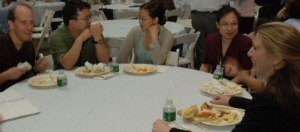 |
Dr. Katherine Calvo, right, shares experiences with other new fellows at reception.
|
After a week working in their new jobs at the Clinical Center, the incoming NIH clinical fellows came together in early July for a welcome reception. As a conclusion to the CC-sponsored orientation program, the reception is an annual tradition that brings together clinical fellows and CC and NIH leaders. It is a unique setting where people from different countries, medical specialties and experience come together to mingle and meet.
The fellows, who participate in a number of clinical training programs at NIH, including many accredited through the Accreditation Council for Graduate Medical Education, typically spend two to five years working in their own clinical specialties with senior clinical investigators. At the beginning of their fellowships, many are still overwhelmed with the size of the campus and the level of research taking place here.
“NIH is not a place you hear about; it is a place you just know. It’s hard not to,�? says Dr. Chimen Kesserwan, a genetics fellow and pediatrician from Lebanon. “When I first started here, I felt like Alice in Wonderland,�? she adds with a smile.
Kesserwan is joined at the table by two other fellows—Dr. Galina Nesterova, also a pediatrician whom she knows from NHGRI, and Dr. Jeanne-Marie Maher, an academic internist from the University of Washington in Seattle, who is working in the CC pain and palliative care program. Despite the different research interests among the three, they chat animatedly about their work. “I think we are all just so happy to meet each other and find our commonalities as physicians,�? Maher says.
After a few minutes, another face arrives at the table as Maher greets the visitor, Juan, with a hello. As introductions take place around the table they learn that “Juan�? is Dr. Juan Lertora—the new director of the CC’s clinical pharmacology program. The group instantly launches into a discussion about the pharmacology program as a couple of the fellows talk about the possibilities for better data on holistic medications.
These moments of interaction between fellows and leaders in their fields are main reasons Dr. Frederick P. Ognibene, director of the CC office of clinical research training and medical education and director of the NIH clinical research training program, feels these events are such an important part of the orientation. “This annual welcome event is a great opportunity for the fellows to meet each other and to meet the NIH and Clinical Center leadership,�? he says.
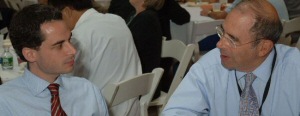 |
CC Director Dr. John I. Gallin speaks with new fellow Dr. Phillip Perez
|
At another table, a group of anatomic pathology fellows listen to Dr. Katherine Calvo, co-chair of FelCom, the NIH clinical fellows committee. She takes the opportunity to talk to the group about participation on the committee. “I don’t think all of the fellows realize how many opportunities there are to make a real difference here,�? she says. “It’s great that you can have an impact.�?
The orientation and reception are just the beginning of a fellow’s time at NIH. The first year’s focus is clinical research and patient care at the Clinical Center. Subsequent training may involve clinical or basic research or a combination of both. Some of the training is offered at partner institutions such as National Naval Medical Center, Children’s National Medical Center and Johns Hopkins University Hospital.
Dr. Mahsa Mohebtash, a native of Iran, appreciates the opportunity to split her time between the Clinical Center and National Naval Medical Center. As an oncology fellow, she will spend her first year at Navy before she moves to the CC. “We first learn conventional, standard chemotherapy at Navy, compared to the clinical trials at the Clinical Center,�? she says. Because the cases at the CC are unique and specialized, Mohebtash explains that the more traditional cases, like those at Navy, are a great way to builda foundation of learning.
Mohebtash ultimately plans to specialize in hematological malignancies but enjoys learning about all facets about oncology treatments. “I prefer to work with liquid tumors because the work belongs solely to the oncologists—unlike solid tumors, which involve surgeons and other physicians. With malignancies, it’s only you, and the treatments are chemical and effective. It is very encouraging work.�?
Every year, the fellows’ reception brings together a unique mix of individuals, and every year the enthusiasm is the same—lively and contagious. They come from Iran, Lebanon, St. Petersburg, Oklahoma, Washington, D.C., and beyond—all with a common interest in medical researchand an admiration for NIH.
—By Kathryn Boswell
Back to Top
Town hall meeting focuses on issues
Management, the CC’s physical environment, workforce issues, CRIS, and new clinical research programs were among topics covered during the CC director’s town hall meeting on June 28.
Several hundred CC and NIH staffers were in the audience as Dr. John I. Gallin summed up the response to challenges ahead, mostly related to a flat-lined budget. “How do we develop and maintain a vibrant community? We spend less and increase efficiency.�?
Working, spending smarter
Most managers and supervisors have completed a four-day session on how best to encourage employees to work effectively. The CC-designed training coincided with implementation of a new performance management appraisal system, which debuted in June.
Keeping unnecessary spending in check and exploring new approaches for purchases are among cost-containment efforts. The Pharmacy Department is leading the charge with strategies expected to trim more than $1 million dollars from its budget over the next year.
“Ten percent of our (total) budget is spent on drugs,�? Gallin said. Many of those dollars cover study-related medications, but it’s been common practice to give CC patients other medicines not related to their studies upon discharge. Providing prescriptions when necessary—not the medicines themselves—will result in significant savings without compromising patient care. The department is also looking at the formulary of drugs it typically stocks and at alternate vendors for other opportunities to streamline.
Another cost-saving strategy being used is the reverse auction. They are similar to how it’s done on eBay, but instead of contractors bidding up the price for a proposed item or service— they bid it down and the contract is awarded to the lowest bidder.
Because CC patients are here to participate in clinical research, they often remain as inpatients for long periods. “If we reduce a CC patient’s stay by half a day, we will save approximately $1.5 million, which is equivalent to the work of 15 nurses,�? Gallin said. “The average stay one year ago was 8.8 days. We have now reduced it to 8.4 days. We’re not going to compromise the quality of data being collected (during a study) or patient care, but we are going to look closely at the length of stay.�?
Brainstorming
A protocol resources utilization think tank—composed of CC and NIH staff—is looking at how to design protocols that make the most efficient use of resources, examining scheduling practices, and recommending improvements in data systems that would allow more uniform allocation of resources.
Gallin also shared other ideas that could—given appropriate reviews and approvals—generate revenue to fund CC operations. “We’re looking to bring money into the Clinical Center in novel ways,�? he said, including a postage stamp celebrating clinical research, a philanthropy program that would allow contributors to give to the Foundation for NIH, collection of royalties for using off-label drugs (drugs used for a purpose other than originally intended), and the establishment of phenotyping clinics, which practitioners worldwide could use to define characteristics of diseases. “We are looking for ways to be better stewards of the taxpayers’—your— dollars,�? he added, and asked for staff to share their ideas to save money. Send suggestions for cost savings to him at JGallin@cc.nih.gov.
Clinical Center atrium
Glass partitions and steel mesh will replace netting installed around the atrium as a result of last year’s tragic event when a patient scaled an eight-foot barrier and fell to his death. Each atrium floor currently has partitions below the metal handrail. The building’s architects worked with hospital and NIH stakeholders to devise a permanent alteration. Matching partitions will be placed above the rail, with spaces between for airflow. Steel mesh will stretch from the top of the glass on the seventh floor to the building’s ceiling. “The cost will be about $10 million,�? Gallin said. “But it is absolutely essential.�?
Clear the Air campaign
The CC’s long-standing no-smoking policy will get renewed attention during an awareness campaign slated to kick off in September. The aim is to make sure staff, patients and visitors know the rules about smoking, that they observe the policy—and how to get help if they want to go tobacco-free.
“There is a part of our environment that has always bothered me,�? Gallin said, “and that’s to have to walk through a crowd of smokers in order to enter the building. We are sending the wrong message as an institution dedicated to promoting health.�?
New research programs
The CC is gearing up to implement two new research programs in the coming months. NIDDK will lead a multi-institute initiative on obesity research. The program comprises ten beds on 5SW and three metabolic chambers on 7SW. A vaccine evaluation clinic is planned for 5NE. The seven-bed unit will be configured for patients’ self-care and incorporate special isolation capability.
CRIS
In the 24 months following activation of the Clinical Research Information System—CRIS—related projects have moved forward. A surgery system initiated in June supports inventory management and OR case scheduling. Expected to begin late summer is a new ADT (admissions, discharge and transfer) system that will serve as a patient registry and support scheduling for their appointments. It replaces the last computer system currently housed in CRIS’s predecessor—the hospital’s decades-old MIS (medical information system.)
Up next are a clinical data warehouse ‘lite’ and a pharmacy system. The warehouse will make information, including clinical documentation, orders and consultation reports contained in CRIS, available to institutes’ data repositories. This is the first step toward a more comprehensive warehouse to support researchers’ data needs.
“It’s important for staff to know about the important work done here, including projects that are being carried out by their colleagues throughout the organization,�? Gallin said after the meeting. “My goal is to have town hall meetings at least twice a year.�?
Back to Top
CC staffers honored with NIH awards
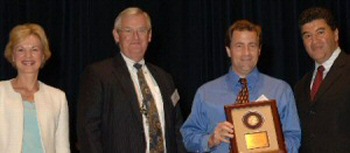 |
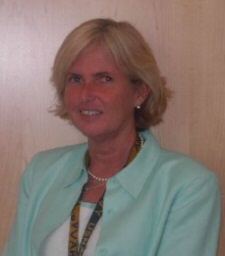 |
Dr. Mark Gladwin (second from right), CCMD and NHLBI, receives NIH director's award from Dr. Zerhouni (right). Dr. Elizabeth G. Nabel, NHLBI director (left) and David Henderson (second from left), CC deputy director for clinical care, are also pictured.
|
Pat Piringer
|
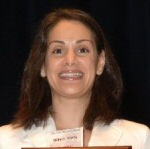
|
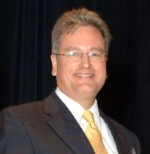 |
 |
Hillary Fitilis
|
Dr. Robert Danner
|
Laura Lee
|
Leadership requires heart, spine and brains, said Dr. Elias A. Zerhouni, NIH director, offering an anatomy lesson in remarks opening his 2006 awardsceremony in July. Heart because we’re “the National Institutes of Hope to millions,�? and spine because it’s important “to stand up for what you believe in, believe in what you say, and say what you believe…stay true to your principles and core values.�?
CC Office of the Director staff honored with individual awards were Patricia Piringer, for outstanding management and oversight of the bench-to-bedside program; Laura Lee, for leadership in emergency preparedness planning and creation of an emergency preparedness partnership; and Hillary Fitilis, for exemplary leadership and guidance in improving performance management here. Dr. Robert Danner, Critical Care Medicine Department, received an individual award for creation of a multi-user genomics facility, yielding substantive insights into the physiologyof sepsis. A mentoring award went to Dr. Mark Gladwin, Critical Care Medicine Department and NHLBI, for his contributions to understanding the role of nitric oxide in sickle cell anemia patients.
Back to Top
2006-2007 Principles of Clinical Pharmacology course begins in September
The CC Principles of Clinical Pharmacology course will begin on September 7 in Lipsett Amphitheater. The course will be held Thursdays from 6:30 p.m. to approximately 7:45 p.m. and will run through April 26, 2007.
“Many medical schools don’t offer formal courses in clinical pharmacology,�? said Dr. John I. Gallin, CC director. “This program covers what researchers need to know concerning the clinical pharmacologic aspects of drug development and use.�?
The course covers topics such as pharmacokinetics, drug metabolism and transport, assessment of drug effects, drug therapy in special populations and drug discovery and development. An outstanding faculty has been assembled to present the lectures, including Dr. Jerry Collins, NCI; Dr. Carl Peck, University of California, San Francisco, Center for Drug Development Science; Dr. Janet Woodcock, FDA; and Dr. Arthur J. Atkinson, Jr., former director of this course. Joining the faculty is Dr. Juan Lertora, the new director of this course and the CC clinical pharmacology program, who will serve as a lecturer for significant portions of the course’s core content.
The faculty has also prepared a textbook, Principles of Clinical Pharmacology, Second Edition, which follows the sequence of the lectures. The course textbook will soon be available in the FAES bookstore. Program staff can suggest other options for purchase. Since the course was first offered nine years ago, it has expanded beyond the CC to include a number of offsite partners. Last year there were approximately 200 students from six long-distance partners in addition to the more than 400 students enrolled at NIH.
Registration is open to all interested individuals at no cost. Certificates will be awarded at the end of the course to students who attend 75 percent of the lectures. Additional information regarding the Principles of Clinical Pharmacology course, including online registration, is available at http://www.cc.nih.gov/training/training/principles.html or by calling (301) 435-6618.
Back to Top
New CIO a veteran in information technology advances here
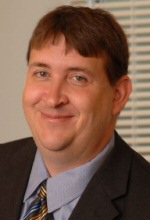 |
Dr. Jon McKeeby
|
Dr. Jon McKeeby has been named the Clinical Center’s chief information officer. Acting CIO since January and at the NIH Clinical Center since 1991, McKeeby also will oversee the Department of Clinical Research Informatics.
“Dr. McKeeby’s experience and expertise are invaluable to the Clinical Center,�? said Dr. John I. Gallin, CC director, in making the announcement. “His dedication to the CC‘s mission and leadership in information technology have been instrumental in the development and implantation of numerous initiatives.�? McKeeby was instrumental in creating the first database of clinical research studies for the CC in the early 1990s and was architect for CRIS, the Clinical Research Information System.
His federal career began in the Medical Record Department while a coop student working on a doctorate in computer science at George Washington University. He went on to head development and web teams for the CC’s information systems department, which eventually split into the Department of Networks and Applications and the Department of Clinical Research Informatics.
McKeeby led the development and implementation of interfaces between MIS, the CC’s original medical information system, and CRIS for other key information systems, including radiology, hospital statistics, nutrition and surgery.
He earned the BS degree in computer science from Hope College in Michigan and an MS in computer science from Bowling Green State University. He has received Clinical Center Director’s Awards for his work on SACRED, an automated credentialing system, intramural protocol data-management services, PACSweb implementation, and CRIS implementation.
Back to Top
National Recreation Therapy Week showcases innovations
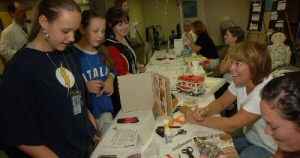 |
Annamarie, Ginamarie and Robin Shrader (standing, left to right) view arts and crafts displayed by Linda Scimeca (seated, second from right), recreation therapist, and Jenny Holland (seated, far right), summer volunteer.
|
The recreation therapy section, CC Rehabilitation Medicine Department, demonstrated the range of their services as part of the American Therapeutic Recreation Association’s National Recreation Therapy Week July 10-14.
Displays outside the second-floor cafeteria included posters, arts and crafts and a friendly dog named Suchie. The offerings changed slightly each day as recreation therapists presented their specialties.
“We decided to do this so people could see all the different things we do in the recreation therapy department,�? said Michael Duquette, a CC recreation therapist who organized this year’s event, which was packed with a variety of recreation therapy presentations.
Included were relaxation techniques, fitness, stress management, heart rate variability, traditional Chinese medicine, music therapy, medical play, massage therapy, beading, pain management, animal-assisted therapy and arts and crafts. All of these programs are available to CC patients through the recreation therapy section.
Holly Parker, a recreation therapist who oversees the animal-assisted therapy program, was on hand one day with program volunteer Harvey Eisen and his Labrador/shepherd mix, Suchi. “We always celebrate Recreation Therapy Week,�? she said. “But this is the first time we’ve set up in this way.�? The animal-assisted therapy program, initiated in 1989, allows volunteers and their certified dogs to visit CC inpatients.
A new program that soon will be available to patients is an artist-tradingcard activity that invites patients to design small cards, which become therapeutic works of art. Once a card is completed, a patient signs the back and can trade cards with other patients and members of the CC community to build a scrapbook or collection of artwork.
Recreation therapist Linda Scimeca and Jenny Holland, a summer volunteer in the section and a student at Sidwell Friends, presented their own arts-and-crafts creations and invited visitors to design their own cards with the provided art supplies. “This is a very sedate activity, which doesn’t require a lot of movement,�? explains Scimeca. “It’s something that is easy to do in bed, but not tedious, and patients can do it in little spurts of time when they are feeling well.�?
“We wanted to highlight all thedifferent aspects of recreation therapy,�?said recreation therapist Kristin Johnsen.
—Kathryn Boswell
Back to Top
Nurse graduates complete internship program
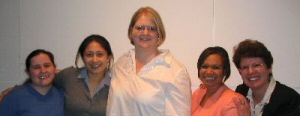 |
Pediatric nursing interns are (left to right) Amanda Urban, Ashleigh Hussey, Caroline Hudson and Tanya Hollingsworth with Claire Waslek, program coordinator.
|
New nurse graduates are invited to apply and participate as interns in the Clinical Center’s Nursing and Patient Care Services every year. In 2005, the 16 students who enrolled in the one-year internship programs had the opportunity to apply their classroom education to hands-on experience in the hospital.
The graduate internship programs are designed to support new registered nurses in developing their skills in a specific specialty. The internship experience includes classroom modules, projects, independent-study, and focused clinical work with unit preceptors, all combined with personal guidance from the internship program coordinator and clinical nurse specialists who serve as mentors. At the end of the program year, each participant receives a certificate of completion and may apply for a fulltime clinical research nurse role in the designated specialty area.
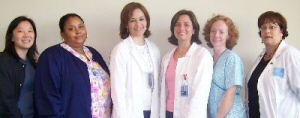 |
Medical-surgical nursing interns are (left to right) Pam Shimabukuro, Diane Murray, Anne Quinn, Sharon Osgood and Sheila Smith, with Kathy Feigenbaum, program coordinator.
|
Shadow experiences for the pediatric interns were chosen in pain and palliative care, pediatric behavioral health, wound care and issues relevant to pediatric patients in need of medical isolation,�? said Claire Walsek, program coordinator for the pediatric internship. On May 23, Amanda Urban, Tanya Hollingsworth, Ashleigh Hussey and Caroline Hudson graduated from the pediatric internship program.
The program coordinator for the oncology internship, Debra Parchen, said, “Each of the seven interns presented their independent study projects to the 3SE and 3NW oncology nurses as a way of giving back to the nurses who helped them throughout the program.�? On June 9, the oncology internship graduated Candace Cottle, Cherron Boswell, Jennifer Baker, Tat’Yana Worthy, Elizabeth Maestri, Paula Schum and Christine McGowan.
�?This year’s interns grew in their knowledge and expertise—they started IV’s, performed endocrine serial testing and did cardiac monitoring,�? said Kathy Feigenbaum, program coordinator for the medical/surgical internship. “They had opportunities spanning all aspects of medical surgical nursing, including kidney transplantation, diabetes, rare genetic disorders and pulmonary disorders.�? On June 15, the medical/surgical program graduated Sharon Osgood, Anne Quinn, Sheila Smith, Pamela Shimabukuro and Diane Murray.
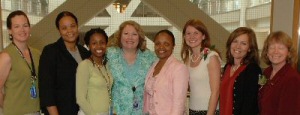 |
Oncology nursing interns are (from left to right) Christine McGowan, Cherron Boswell, Candice Cottle, Deborah Parchen (program coordinator), Tat'Yana Worthy, Jennifer Baker, Paula Schum and Elizabeth Maestri.
|
This summer, 16 new nursing graduates joined the CC Nursing and Patient Care Services in internship programs in neuroscience, oncology and medical/surgical nursing.
—Cynthia Herringa
Back to Top
Language interpreter volunteers needed to assist CC patients
The volunteer language interpreters program is seeking volunteers in the following languages to assist Clinical Center patients who have limited English proficiency: Korean, Mandarin, Spanish, French, Japanese and Portuguese. Volunteers operate on an on-call basis and should have some prior medical knowledge in order to communicate effectively with patients and families.
“It is not just about the language,�? says Fay Darya, a CC language interpreter. “Patients need someone to talk to, someone who will understand them— their background, culture or religious beliefs—in addition to their medical condition.�?
Contact Andrea Rander, director of volunteer services in the Social Work Department, at (301) 496-1807 for more information on how to volunteer.
Back to Top
NIH welcomes new director of clinical pharmacology program
The CC office of clinical research training welcomed Dr. Juan Lertora as the new director of the CC clinical pharmacology program in July.
As program director, he will teach and oversee the Principles of Clinical Pharmacology course and will be involved in issues related to training clinical investigators. Lertora also says he is interested in pursuing ongoing discussions with clinical investigators. “If investigators are preparing clinical research protocols and feel that the input of a clinical pharmacologist would be helpful, I will be a consultant in that sense,�? he said. “I am looking forward to interacting and collaborating with them.�?
“The Clinical Center’s clinical pharmacology program offers a course designed to meet the needs of researchers interested in the pharmacological aspects of drug development,�? said Dr. John I. Gallin, CC director. “And we are delighted to have Dr. Lertora at the helm of this important complement to the CC’s other clinical research training programs as well as to work with others in the CC to foster growth of these programs in general.�?
Lertora’s passion for his work and for instilling the academic and professional know-how in his students is evident. He is animated about his NIH projects and is quick to mention what an incredible opportunity it is to be invited to serve at a place like the CC. And while he is excited about his new role, Lertora’s journey to NIH has not been without heartache.
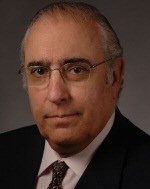 |
| Dr. Juan Lertora, Director, CC clinical pharmacology program
|
Before accepting the job at the Clinical Center, Lertora worked as a professor and head of the section of clinical pharmacology at Tulane University’s Departments of Medicine and Pharmacology in New Orleans. In addition to his academic positions at Tulane, he was a staff physician at Tulane Medical Center Hospital and Clinic, Charity Hospital and Veterans Administration Medical Center—all in New Orleans. He also was a principal investigator in the Tulane-Louisiana State University Adult AIDS Clinical Trials Unit, which was funded by NIAID, and the program director of the General Clinical Research Center (funded by NCRR).
When Hurricane Katrina hit in August 2005, Lertora evacuated the city—his home for more than 20 years—with thousands of others, ultimately ending his journey in Houston.
“This was the first time I had left New Orleans because of a hurricane threat,�? he said. “We all thought we would be back in 24 to 48 hours.�?
The days turned into months as Lertora and his students were assigned temporary offices and fellowships throughout Texas. Baylor’s clinical pharmacology department invited Lertora to use an office for the remainder of the academic year in Texas.
“Charity is still closed, Tulane opened but is using only 60 of the 300 beds previously available, and the VA opened for ambulatory care only. The scenario for infrastructure, medical care and education has changed dramatically.�?
That change was enough to make Lertora consider leaving the town he called home. So when he became aware early this year that the CC position was still open, he was ready to consider the opportunity. Dr. Arthur Atkinson, who served the role until October 2005, was a friend and mentor.
“I remember congratulating Art when he retired from his position as director of the clinical pharmacology program last year. At the time, I had no idea I would be looking for a new opportunity,�? Lertora says.
Dr. Frederick P. Ognibene, director of CC office of clinical research training and medical education and director of the NIH clinical research training program, was pleased to welcome Lertora to the program. “While at Tulane, Dr. Lertora served as an active clinical researcher and program director of their large General Clinical Research Center,�? Ognibene said. “That expertise will be invaluable as the CC carries out and plans for growth of its clinical research training and medical education initiatives.�?
For a man who boarded a cargo ship in 1970, leaving his native Argentina behind to study in the United States, adventure is familiar to Lertora. With a medical degree from National University of the Northeast, Faculty of Medicine in Corrientes, Argentina, a Ph.D. in pharmacology from Tulane University, and a distinguished academic and professional career in clinical pharmacology—Lertora is ready to hit the ground running. What tops his “to-do�? list? “Right now I am thinking in broad terms. I would like to continue to work with pharmacokinetics and to meet clinical investigators at NIH to explore where we have common interests. I also have an interest in drug discovery and development.�?
Dr. Juan Lertora can be reached at (301) 451-7117 or lertoraj@cc.nih.gov.
—By Kathryn Boswell
Back to Top
Medicine for the Public lectures begin September 26
The CC will present its annual series of lectures on important health topics Tuesdays September 26-October 31. The lectures are free and open to the public. All begin at 7 p.m. in the Masur Auditorium.
Tuesday, September 26
“Preventing the Nation’s Leading Cause of Death: Heart Disease�?
Dr. Denise Simons-Morton
Director, Clinical Applications and Prevention Program, Division of Epidemiology and Clinical Applications, NHLBI
Heart disease is the leading cause of death in the United States, with almost 700 thousand deaths a year. In addition, about 22 million adults in the U.S. live with heart disease. This lecture will cover factors that increase the risk of getting heart disease and what can be done to reduce, prevent and improve its outcome.
Tuesday, October 3
“Stroke Update�?
Dr. Steven Warach
Chief, Stroke Diagnostics andTherapeutics Section, NINDS
More than 700 thousand Americans have a new or recurrent stroke each year. Understanding the human brain—the body’s most complex organ—continues to be a challenge for stroke research. Thislecture will include an overview of the causes of stroke, symptoms and research for new stroke treatments.
Tuesday, October 10
“Tuberculosis in the 21st Century: Old Problem, New Understanding�?
Dr. Steven M. Holland
Chief, Laboratory of Clinical Infectious Diseases, NIAID
Tuberculosis is a worldwide health problem with an estimated 8.8 million new cases in 2003 and approximately 2 million deaths a year. Underlying medical conditions may increase TB risk, such as HIV infection, diabetes and renal failure. Dr. Holland will explain why some people infected with Mycobacterium tuberculosis develop this disease while others don’t, how it is detected, current treatment options and new research directions.
Tuesday, October 17
“The Role of the Gut, Hormones and the Brain in Obesity�?
Dr. Monica C. Skarulis
Chief, Clinical Endocrine Section, Clinical Endocrinology Branch
Director, Inter-Institute Training Program in Endocrinology, Diabetes and Metabolism, Acting Director, NIHIntramural Obesity Research Initiative
Sixty-five percent of the US population carries extra weight; 31% (61 million) are considered obese. The list of medical maladies associated with obesity is long, and obese people have a shorter life expectancy than lean individuals. This lecture will discuss how research is unraveling the complex networks controlling eating behavior, as well as the importance of exercise and sleep on weight control.
Tuesday, October 24
“AIDS After 25 Years: Lessons Learned for Other Emerging Infections�?
Dr. Henry Masur
Chief, Critical Care Medicine Department, CC
When AIDS swept the nation 25 years ago, the population panicked. Scientists were pressured to approve drugs quickly. They had to battle public perceptions while trying to follow the painstaking scientific process of gathering data and developing treatments. Dr. Masur will explain how those experiences are shaping how scientists will deal with new emerging infections, such as bird flu, SARS and West Nile virus.
Tuesday, October 31
“Depression: Impact, Causes, and Current Research�?
Dr. Peter Schmidt
Chief, Unit on Reproductive Endocrine Studies, Behavioral Endocrinology Branch, NIMH
Depression is a leading cause of diseaserelated disability worldwide and is twice as common in women as in men. Not only is depression associated with significant emotional distress, but it also confers an increased risk for several other medical illnesses. Dr. Schmidt will describe recent efforts to identify the underlying biology of depression, its relevance to women’s health and potential new therapies.
The Medicine for the Public series was established in 1978. For more information, including parking and directions, call Clinical Center Communications, (301) 496-2563 or go online, http://clinicalcenter.nih.gov/about/news/mfp.shtml.
Back to Top
Clinical Center News, National
Institutes of Health, Building 10, 10 Center Drive, Room 12C440, Bethesda, MD 20892-1504. Tel: 301-496-6787.
Fax: 301-402-2984. Published monthly for CC employees
by the Office of Communications, Patient Recruitment, and Public Liaison. News, article ideas,
calendar events, letters, and photographs are welcome.
Back to Top
|
|


 The information on this page is archived and provided for reference purposes only.
The information on this page is archived and provided for reference purposes only.